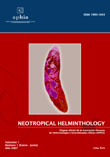BIODIVERSITY OF INVERTEBRATES OF PUERTO VIEJO WETLAND, LIMA, PERU
DOI:
https://doi.org/10.24039/rnh2007111149Keywords:
biodiversity, copepod, limnology, nematode, rotifer, wetlands.Abstract
Puerto Viejo is a coastal wetland of importance for resident and migratory birds conformed by several seasonal, natural and artificial water bodies with high salinities. This ecosystem is located to the south of Lima, Peru. In June of the 2004 surveys of the biodiversity and abundance of the invertebrate community were carried out, representing a spatial heterogeneity of different littoral water bodies in 28 stations of sampling distributed in five lagoons dispersed in all marsh area. Distribution of stations by lagoon were: lagoon 1 (n=2): stations 1 and 2; lagoon 2 (n=5): stations 3 to 7; lagoon 3 (n=6): stations 8 to 13; lagoon 4 (n=9): stations 14 to 22, and finally lagoon 5 (n=6): stations 23 to 28. The samples of zooplankton were collected using a plankton net of 75 of diameter and preserved using a solution of formalin sweetened to 4 %. In addition, some limnological parameters like conductivity (Ohms•cm-2), coefficient of extinction, temperature of the water (°C) and temperature of the air (°C) in each station of sampling were determined. The results indicated the presence of 40 taxa, being more abundant and frequent; the rotifers Brachionus calyciflorus (Pallas, 1776) and Lecane lunaris (Ehrenberg, 1831), the nematode Rhabdolaimus sp. Man, 1980, the copepod Cyclops strennus (Fisher, 1851), insect Chironomini and the foraminifer Globoratalia scitula Brady, 1877. The number of organisms by liter (N° org. L-1) was of 14 (4-45) and the number of taxa by sampling station was of 10 (5-20). The diversity index mean of Shannon-Wiener was relatively high. Similarity indexes showed values higher than 30% of similarity between 28 stations of sampling. It concluded that 37 of 40 taxa are new records for Puerto Viejo wetland, Lima, Peru.
Downloads
Published
How to Cite
Issue
Section
License

This work is licensed under a Creative Commons Attribution-NonCommercial-NoDerivatives 4.0 International License.
OBJETO: El AUTOR-CEDENTE transfiere de manera TOTAL Y SIN LIMITACIÓN alguna al CESIONARIO los derechos patrimoniales que le corresponden sobre la (s) obra(s) tituladas: xxxxxxxxxxxxxxxx, por el tiempo que establezca la ley internacional. En virtud de lo anterior, se entiende que el CESIONARIO adquiere el derecho de reproducción en todas sus modalidades, incluso para inclusión audiovisual; el derecho de transformación o adaptación, comunicación pública, traducción, distribución y, en general, cualquier tipo de explotación que de las obras se pueda realizar por cualquier medio conocido o por conocer en el territorio nacional o internacional.
REMUNERACIÓN: La cesión de los derechos patrimoniales de autor que mediante este contrato se hace será a título gratuito.
CONDICIONES Y LEGITIMIDAD DE LOS DERECHOS: El AUTOR-CEDENTE garantiza que es propietario integral de los derechos de explotación de la(s) obra(s) y en consecuencia garantiza que puede contratar y transferir los derechos aquí cedidos sin ningún tipo de limitación por no tener ningún tipo de gravamen, limitación o disposición. En todo caso, responderá por cualquier reclamo que en materia de derecho de autor se pueda presentar, exonerando de cualquier responsabilidad al CESIONARIO.
LICENCIA DE ACCESO ABIERTO: El AUTOR-CEDENTE autoriza que manuscrito publicado en La Revista Neotropical Helminthology permanece disponible para su consulta pública en el sitio web https://www.neotropicalhelminthology.com/ y en los diferentes sistemas de indexación y bases de datos en las que la revista tiene visibilidad, bajo la licencia Creative Commons, en la modalidad Reconocimiento-No comercial- Sin Trabajos derivados –aprobada en Perú, y por lo tanto son de acceso abierto. De ahí que los autores dan, sin derecho a retribución económica, a la Asociación Peruana de Helmintología e Invertebrados Afines (APHIA), los derechos de autor para la edición y reproducción a través de diferentes medios de difusión.


 Numero 2 Volumen 19 - 2025 (versión Anticipada)
Numero 2 Volumen 19 - 2025 (versión Anticipada)














































